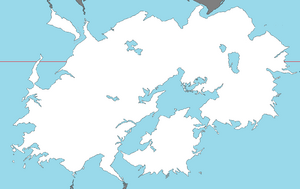Adula: Difference between revisions
No edit summary |
No edit summary |
||
| Line 30: | Line 30: | ||
}} | }} | ||
'''Adula''' is the second-largest {{wp|continent}} located on the planet of [[Iearth]]. The vast continent is bounded by the bustling [[Olympic Ocean]] and [[Toyana Ocean]] to the east and the [[Samson Ocean]] to the west. It is bisected from [[Euronia]] by the [[Strait of Quetana]] and from [[Antartique]] by the [[Strait of Drendarich]]. | '''Adula''' is the second-largest {{wp|continent}} located on the planet of [[Iearth]]. The vast continent is bounded by the bustling [[Olympic Ocean]] and [[Toyana Ocean]] to the east and the [[Samson Ocean]] to the west. It is bisected from [[Euronia]] at the Western [[Zamastan]] islands by the [[Strait of Quetana]], from [[Nortua]] at [[Birnir]] by the waterway of [[Yn Syth]] and at [[Greland]] by the [[Strait of Greland]], and from [[Antartique]] by the [[Strait of Drendarich]]. | ||
Given its size and diversity, the concept of Adula—a name dating back to classical antiquity—may actually have more to do with human geography than physical geography. Adula varies greatly across and within its regions with regard to ethnic groups, cultures, environments, economics, historical ties and government systems. It also has a mix of many different climates ranging from the equatorial south via the hot desert in the East, temperate areas in the south-central regions and the continental center to tropical western divisions. | Given its size and diversity, the concept of Adula—a name dating back to classical antiquity—may actually have more to do with human geography than physical geography. Adula varies greatly across and within its regions with regard to ethnic groups, cultures, environments, economics, historical ties and government systems. It also has a mix of many different climates ranging from the equatorial south via the hot desert in the East, temperate areas in the south-central regions and the continental center to tropical western divisions. | ||
Revision as of 16:41, 27 April 2020
 | |
| Population | 4.3 Billion |
|---|---|
| Population density | 100/km2 |
| GDP (PPP) | $65.44 trillion |
| GDP per capita | $7,350 |
| Countries | [[List of sovereign states and dependent territories (Iearth)|]] |
| Largest cities | |
Adula is the second-largest continent located on the planet of Iearth. The vast continent is bounded by the bustling Olympic Ocean and Toyana Ocean to the east and the Samson Ocean to the west. It is bisected from Euronia at the Western Zamastan islands by the Strait of Quetana, from Nortua at Birnir by the waterway of Yn Syth and at Greland by the Strait of Greland, and from Antartique by the Strait of Drendarich.
Given its size and diversity, the concept of Adula—a name dating back to classical antiquity—may actually have more to do with human geography than physical geography. Adula varies greatly across and within its regions with regard to ethnic groups, cultures, environments, economics, historical ties and government systems. It also has a mix of many different climates ranging from the equatorial south via the hot desert in the East, temperate areas in the south-central regions and the continental center to tropical western divisions.
Adula is home to some of the most influential nations in the world both in terms of historical impact and modern day connection, including Cadair, Emmiria, Austrolis, Quetana, and Skith.
Etymology

Adula was originally a concept of Verdusan civilization in the 6th century B.C.E., with the idea of an extensive landmass beyond the deserts of Emmiria that flourished with lucrative kingdoms connected by networks, such as the Bezdekia Road linking modern-day Mulfulira with Zudrait, being some of the first commonly used trading routes in the world.
History

Geography
Regions
Adula, due to its immense size, is generally divided into three subcontinental categories: Eastern, Western, and Southern. These are generally categorized by geographical features. The southern division is most distinguishable due to its status as a centrally located island and surrounding islands separated from mainland Adula. The east and west, besides their obvious namesake separation, are distinguished by biome and climate differences. Eastern Adula tends to be more dry, consisting of deserts and semi-arid climates, while Western Adula is typically more humid and consists of tropical rainforests on the Samson Ocean side, ascending into high-altitude mountains, and descending towards the Strait of Austrolis with temperate deciduous forest.

